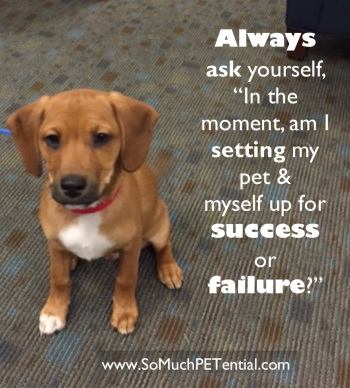Last night this cute little guy was my demonstration puppy in a behavior class. As he and his parents found seats in the back of the room, I had them put him on the ground. There he was a bundle of happy-go-lucky spirit so excited by the new smells and friendly humans that surrounded him. His tail was wagging back and forth as he went from person to person, sniffing the floor, soliciting attention.
I asked the question, “In that moment, would I be setting him up for failure or for success if I asked him to do a behavior he did not yet  have on cue in distracting environments?” (or something like that)
have on cue in distracting environments?” (or something like that)
There was a resounding answer coming from the tables..”failure.”
That was exactly the answer I was looking for. That question is such an important one to ask ourselves often when it comes to our expectations with our pet. As teachers, it is up to us to make our classroom conducive to learning for our students.
Some of the ways we set our pet up for success are by teaching in an environment where he is not distracted beyond his abilities to remain focused and at a time when he is motivated for learning, breaking the behavior down into approximations our pet can easily learn (please see my post on shaping), and using reinforcers that are of value to our student.
Some of the ways we may set our pet up for failure are repeating a cue over and over again (a sign that our pet does not know the behavior well enough), not managing the environment to prevent practice of unwanted behavior, not spending the time to thoroughly teach and proof behaviors with a variety of criteria (only proceeding as our pet shows us he is able to succeed), not making the choice we want our pet to make the most valuable choice for them, and asking for the behavior in an environment that has strong competing reinforcers which your pet has learned offer greater value than listening to you, and trying to teach at a time when our pet does not have the motivation.
In last night’s classroom, if I had asked my demo puppy to sit when he just came into a new environment with so many fun things to explore my chances of getting his focus would have been greatly diminished.
When I did most of my demonstration work with him was later in the class when he was able to focus…and then he came when I called, he sat quickly when asked, he walked on a loose leash at my side around people (with reinforcement from me), and I was able to teach him to stay seated while someone approached.







